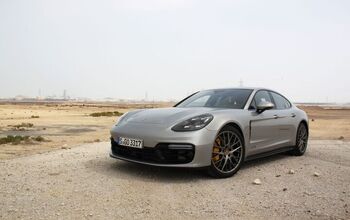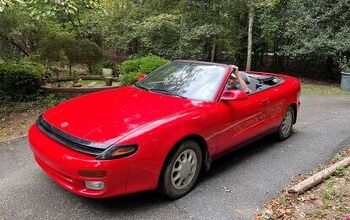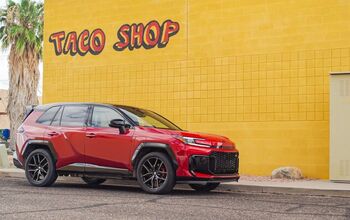2025 Porsche Panamera GTS Review: Pure Athleticism

“Pure” isn’t how I planned on describing a 4,600-pound, twin-turbo, all-wheel drive sedan, but here we are.
It’s not as if the Porsche Panamera isn’t a tech-fest on wheels; it is, and they all are. But if you move up to any of the more powerful models in the lineup, you gain a plug-in hybrid powerplant and even open up the option of the wickedly competent (and pricey) Porsche Active Ride system, which effectively eliminates any body roll. It was enough to wow me in the 4S E-Hybrid I drove earlier this year. The 2025 Porsche Panamera GTS steers clear of those electric-powered assists though, with a (relatively) pared back approach focusing on the sport sedan essentials.
Thus the GTS is the most driver-focused version of the brand’s largest, most luxurious model—an oxymoron on paper, yet after a week with this Carmine Red tester, I didn’t want to give it back.
2025 Porsche Panamera GTS Quick Take
With a steelier, ICE-only edge, the 2025 Porsche Panamera GTS is a unique option amongst the larger sedan landscape: sharper, more indulgent, and full of character.
What’s New for 2025:
Porsche started the Panamera’s updates last year, and the model lineup progresses for 2025. The GTS is back, of course, and it once again comes with Porsche’s sweet 4.0-liter V8. There’s been a 20-pony bump, now totalling 493 horsepower; torque peaks at 486 pound-feet. The power still all heads through the excellent eight-speed PDK to all four wheels, too.
While the GTS skips the Active Ride—which needs a big battery pack to draw from—it does benefit from the twin-chamber air suspension that is now standard across the Panamera family. The new setup allows for more precise control over both rebound and compression.
Exterior Style:
Without wanting to go too off-course here, can I just take a few seconds to commend Porsche for massaging its design language to accommodate models as different as the Panamera and Cayenne? The current models still have obvious ties to the flagship 911, but are handsome and appropriately shaped for their segments. Do you remember the first generation of both? Oof.
The changes for this generation are subtle: the lines are crisper, with squared-off headlights and a single-height rear light bar. Some things haven’t changed, like the cool three-piece extending rear spoiler.
The Panamera GTS follows the recipe that those three letters have spelled out for over a decade at this point. The Carmine Red paint is contrasted with plenty of black-out trim bits, including the bar running across the standard Sport Design front bumper. Everything sits 0.4 inches (10 millimeters) closer to the ground, with large 21-inch center-lock alloys filling the arches. (Are center-locks silly on a road car? Yes, probably.) Those big wheels come slathered in Michelin Pilot Sport 5 S rubber, a generous 275-width layer up front and a huge 325 out back.
2025 Porsche Panamera GTS: All the Details
Powertrain and Fuel Economy:
My brain tells me that this is the inferior circa-500-horsepower Panamera powertrain. The 4S E-Hybrid had more power and more torque, and while this is one of the most responsive V8s out there, it can’t match the instant shove of the plug-in’s electric assist.
My brain also shuts right up the first time the digital tach needle swings north of 6,000 rpm.
With a fulsome sound from the sport exhaust and oh-so-clean responses from the right pedal, that V8 is a sweetheart. It’s just quick enough to offer real face-flattening acceleration, but for fractionally longer—and thus, more often—than something as ballistic as the Turbo S E-Hybrid. Porsche says 62 mph (100 km/h) will flash up in just 3.8 seconds, and like most modern Porsches, that feels conservative when utilizing the easy-peasy launch control. The PDK ‘box is as flawless as ever, always in the right gear for the task at hand, and capable of swapping up (or down) as quick as the driver demands. Sport mode adds a bit more character to the exhaust while remaining civil enough to stay on the neighbors’ nice list.
Handling and Drivability:
It feels like a cliché to say a sedan like the Panamera GTS handles like a sports car. But this is Porsche we’re talking about; it’d be weird if the Panamera didn’t, after all. That new suspension gives the Panamera rock-solid body control, allowing it to cruise over bumps that would upset lesser sport sedans. The thin steering wheel has natural weighting and good feedback, keeping the driver in a constant two-way conversation. Like so many GTS models before it, the Panamera eggs you on, safe in the knowledge that the indulgent chassis and oodles of grip will keep the fun going and the shiny side up.
The Panamera already drove smaller than its dimensions suggested; the rear-axle steering equipped here chops another foot or two out of the effective wheelbase at low speeds, and contributes to a sure-footed feel at speed. I can think of few vehicles likely to be quicker than this on my usual wriggly back-road test route.
Ride Quality and Comfort:
No surprise here: without Active Ride, the GTS is not as smooth as the 4S E-Hybrid. It’s not far off either, mind you: around town is where the ride is at its most brittle, having to deal with speed bumps and potholes with such thin sidewalls is always going to be tough. Get out onto the highway and the Panamera is planted and secure, staying laser-focused on its intended line even when encountering diagonal imperfections.
Porsche’s 18-way adjustable sport seats are superb: supportive where you want ‘em, but in no way restricting ingress and egress. The driving position is sports car perfect, low but with clear sightlines and a wheel right at the correct height. Unless you play in the NBA—and maybe even still—you should be able to get comfortable behind the right-sized steering wheel.
Interior Style and Quality:
Restrained. Confident. Classic. I could use any of those descriptors for the Panamera’s black-and-red cabin; okay, “classic” is tough when touchscreens take up much of the vertical face of the dashboard. The architecture is pleasantly simple however, and it’s all screwed together with the unerring precision Stuttgart is known for. If a black surface isn’t leather, it’s grippy Race-Tex.
Except the center console. While this part of the cabin has been getting wider and wider, there are fewer buttons in 2025 than ever before, leaving a big expanse of piano black. What is left is a mixture of clicky switches (yay) and touch controls (nay).
Back-seat room is generally adult-friendly, though taller folks may find that stylish roofline messing up their perfectly coiffed hair. Now a four-seater as standard with a middle seat optional, the Panamera gives the rear-seat riders their own climate controls mirroring those up front, only minus ventilated seats. Good luck fitting someone back there without mucking up the controls.
Tech and Safety:
The Panamera’s infotainment is the same one we’ve seen in many Porsches over the last few years, but not the absolute latest Android Automotive OS-based setup from the Macan EV and revised Taycan. Largely, that is okay: the older setup is quick to respond and easy to navigate. It does lack the useful additional native integration that the big G provides, sure, but the wireless Apple CarPlay hooks up painlessly. Porsche’s head-up display is bright and easy to read, though again, this lacks the latest functionality found on newer models, such as augmented reality navigation.
Like the 4S E-Hybrid, this tester also features a passenger-side screen, and just as it was there, it’s largely useless here. Why does the passenger need a mirrored version of the center screen, just stripped of functionality? Buy yourself a decent laptop instead, because that’s what it costs ($1,680 / $1,850 CAD).
Value Dollars and Sense:
The GTS doesn’t just sit in the middle of the Panamera family; it’s priced that way, too. This Canadian-spec model kicked off at $176,350 CAD including destination, and its myriad options bring it to $204,360 CAD. I’d argue some of those are necessary, like the rear-axle steering ($1,390 / $1,530 CAD), and premium package ($5,560 / $6,760 CAD); the latter not so much for Porsche InnoDrive, but for the trick HD-Matrix headlights, four-zone climate control, 360-degree camera, and rear heated seats. I’d also likely upgrade the ventilated seats to both rows. The 2+1 seating ($1,040 / $1,150 CAD) and full Assistance Package (Technology Package in Canada) probably isn’t worth the $4,590 ($5,060 CAD) unless you’re regularly driving pitch-black areas where the night vision is actually useful. Just check the HUD standalone box if you like those sorts of setups.
Pricing for the 2026 Panamera has already gone up: $165,050 to start in America, $179,350 CAD in Canada.
Final Thoughts: 2025 Porsche Panamera GTS Review
Do I still think the Panamera 4S E-Hybrid is the ultimate all-rounder? Sure, it’s the rational choice.
But these are six-figure Porsches we’re talking about: there’s nothing rational about ‘em. As good as the E-Hybrid and its Active Ride are, those who want even more sports car mixed into their one-car-to-rule-them-all will gravitate towards the GTS. The V8 powertrain has real character, and while the suspension isn't quite so elastic, there's a focus that gives this Panamera a real sense of fitness for purpose. Of (relative) pared-back simplicity. Of... purity.
Become an AutoGuide insider. Get the latest from the automotive world first by subscribing to our newsletter here.

Kyle began his automotive obsession before he even started school, courtesy of a remote control Porsche and various LEGO sets. He later studied advertising and graphic design at Humber College, which led him to writing about cars (both real and digital). He is now a proud member of the Automobile Journalists Association of Canada (AJAC), where he was the Journalist of the Year runner-up for 2021.
More by Kyle Patrick










































Comments
Join the conversation
Those headlights are not attractive. Also....needs a manual.